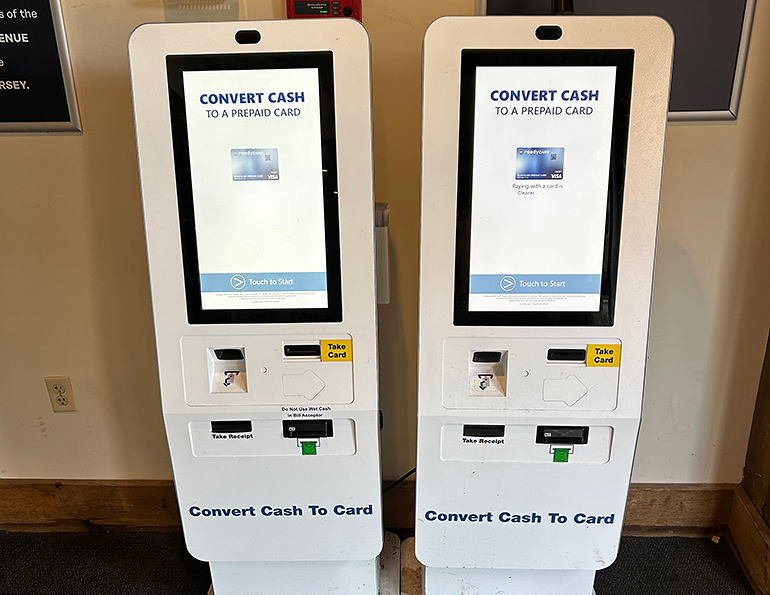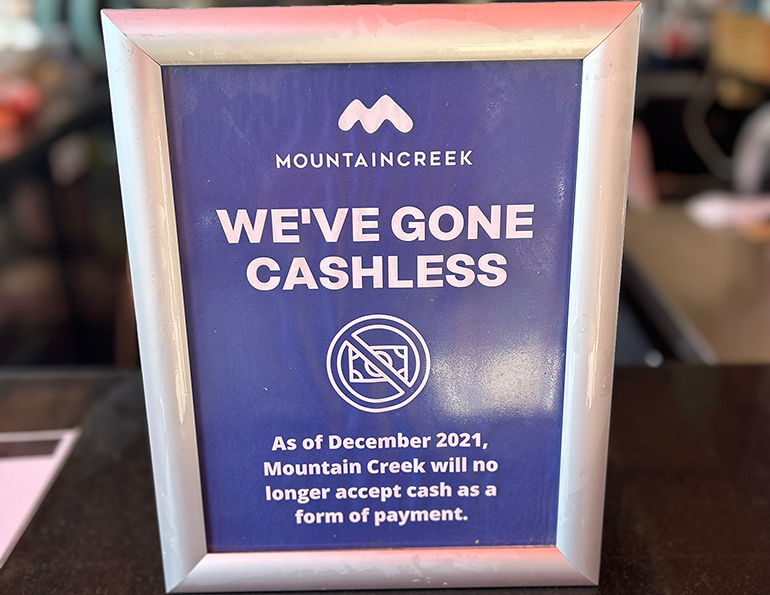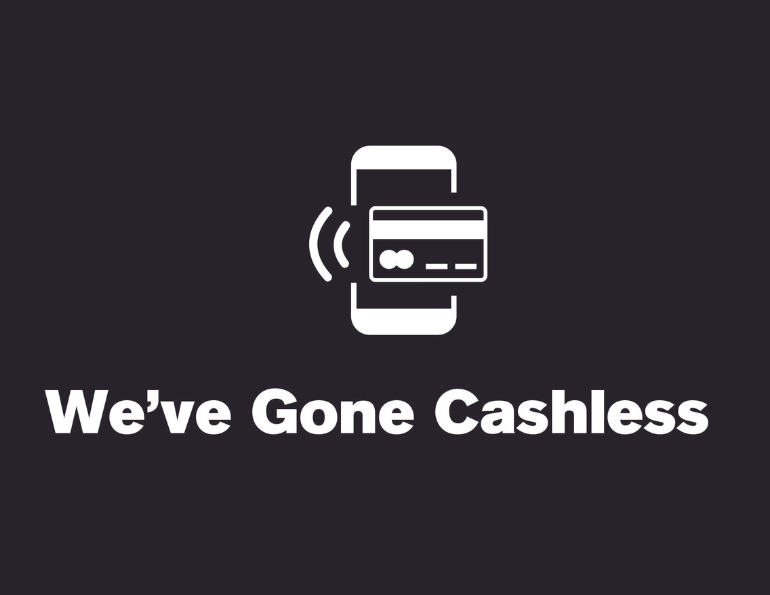Back in the day, head-out-to-ski prep looked like this: tighten up your rear-entry Hanson boots, snap your safety straps on, and—before pulling those leather mittens back over those icy cold hands—check your pocket for the necessary $10 bill (lunch, hot cocoa, emergency).
Those rear entry boots? History. Safety straps? Thankfully replaced by click-in ski brakes. Hands? No longer cold. The only thing left from that bygone era may be the cash.
Or is it?
More and more resorts, spurred by the unique needs of the pandemic, are moving toward making cash payments a thing of the past. And while a small percentage of skiers and riders are pushing back, most are finding the transition to cashless systems not just semi-seamless, but beneficial in many ways.
PAYING, POST-PANDEMIC
Killington Mountain Resort, Vt., had been exploring the idea of going cashless since the pandemic, when the resort—by necessity—did away with ticket windows. That got them thinking, says Killington president Mike Solimano.
“The pandemic brought on a whole bunch of new things,” he says. “We’d been considering cashless, and once we got the first piece (no ticket windows), we thought more.”
It was a team trip to Snowbird, Utah, for Octoberfest in 2022, however, that tipped the team to act. Snowbird had made the move to only credit cards and a few reverse ATMs that August, after the idea had sprung up several times in discussions with on-mountain point-of-sale teams, says Ian Russell, Snowbird’s director of finance.
 Reverse ATMs are one tool resorts are using to move towards cash-free operations. The machines are exactly as they sound: put cash in and receive a pre-loaded debit card in exchange.
Reverse ATMs are one tool resorts are using to move towards cash-free operations. The machines are exactly as they sound: put cash in and receive a pre-loaded debit card in exchange.
“We saw it in action there and came home and said, ‘It’s time,’” Solimano says. Snowbird’s relatively new system seemed to be working seamlessly, even during one of its busiest events of the year.
Almost cash-free already. With more than 200 spots across Killington that accepted cash, and only about 5 to 6 percent of customers still paying with it, says Solimano, it made sense to make the move.
Embracing cash-free, which the resort did starting opening day of the 2022-23 season, required some educating and, yes, listening. “Cashiers all across our resort were teaching the locals to use Apple Pay,” Solimano says. “The young kids? They were fine with it. It was the folks my age (50s) that had to adapt.”
READY FOR IT
Like Killington, SNOW Partners, owner of New Jersey’s Mountain Creek and Big SNOW ski areas, also pivoted to cash-free because of the pandemic, though it had already been moving in that direction: ticket booths were removed from Mountain Creek in 2017.
Still, the pandemic pushed the resorts to go at it faster than they usually would with such a cultural change, says Joe Hession, founder and CEO. “It was a reactionary thing.”
SNOW Partners found that the public was ready for it. “As soon as we made the decision, it changed everything,” says Hession. “Cash has to be physical and has to be transactional. Now, you don’t really need a point of sale. It can be floating.”
Due diligence. Hession and his team had already studied cashless destinations near them. “We did a lot of benchmarking around New York City,” he says. Broadway has been cash-free for some time, he notes, and so have major sporting venues.
“It was at Giants Stadium where I saw my first reverse ATM machine,” he says. “It seemed to be working well.” (Reverse ATMS are exactly as they sound: one puts in cash and receives a pre-loaded debit card in exchange.)
An app for that. The transition has been so successful, SNOW Partners will take the next step this coming season, when guests will be required to have an app to pay for anything at the resorts. “People are ready for it,” Hession insists. “This is the future, that every guest has their own app and all transactions for them happen there.”
Guests will need to download the app to any kind of smartphone. If a person doesn’t have one, they have old-school options like printing out an RFID card, which, admits Hession, will likely require a few extra steps but will be worth it, he says.
HURDLES
Resorts that have gone cashless say they encountered few—shockingly few—hurdles. The biggest situations to stay ahead of? How to educate the public on how it works; how to let people know, but also be ready in case they show up not knowing; how to solve the challenge for staff used to being tipped; and most of all, “What about the kids?”
The kids are alright. The kid aspect was the biggest worry resorts heard, and continue to hear, from guests. Parents—the less tech-savvy among them, anyway—are used to clicking a kid’s pass on and tucking a $20 into their pocket.
Hession says that may be an “#OkayBoomer” concern.
“Anyone who says that doesn’t have young kids,” he says. “Today’s parents would say, ‘Are you kidding? I’d never send my kid out of the house without a phone.’ There are even some schools that don’t take cash now.”
Staff at Killington have helped assuage concerned parents by educating them on how to set up Apple Pay on the kids’ phones and/or teaching them how to purchase a reverse ATM card to tuck in their kids’ pockets just like cash.
Not that many resort customers feel a need to access a reverse ATM, though; Snowbird’s machines averaged just 17 uses per day over the 2022-23 winter season, says Russell.
COMMUNICATION IS KEY
With good communication, angst can be avoided even without on-site solutions like reverse ATMs, say resorts.
Vail Resorts went cashless in late 2022 after “the pandemic initiated and accelerated the transition,” and, says spokesperson Sara Dixon, had little pushback or complaints, despite the choice to not install reverse ATMs. She believes cross-departmental communications to guests about the change played a role.
Setting expectations. “Transparency and proactively setting guest expectations has been essential to the successful rollout of all new innovations, including going cashless,” says Dixon. “Communicating to guests what to expect is critical to helping them plan their day at our resorts.”
Hession agrees. “What’s critical is having clear communication and setting the guests’ expectations before they arrive,” he says. Mountain Creek and Big SNOW utilized email blasts, clear website messaging, explanations to those making purchases, and all social media channels. “It’s just so normal, it wasn’t a big deal,” he says.
 This winter, visitors will need an app to pay at Mountain Creek and Big SNOW, N.J.
This winter, visitors will need an app to pay at Mountain Creek and Big SNOW, N.J.
TRIAL BY FIRE
Minnesota’s Lutsen Mountains—along with its sister resorts—was in the process of moving toward cashless, with plans to market ahead of time, send FAQs to prior guests, and spread the word through all the usual channels. Then crisis hit in June 2023: a fire destroyed not only Lutsen’s restaurant, but its data system, prompting the decision to pivot immediately to cash-free, says co-president Charlotte Skinner.
Follow-up education. The resort, which now takes only major credit cards and contactless payments (e.g., Apple Pay), plans to follow up with education and marketing in the form of emails to early pass product purchasers, FAQs on the resort’s website, social media blasts, and, once at the resort, reverse ATMs with well-placed signage stationed at areas of convenience.
“We want to be sure guests are all set before they end up some place where not being ready [for cash-free] is inconvenient,” Skinner says.
Renting reverse ATMs. Lutsen rented its reverse ATMs through Mobile Money, which specializes in mobile-centric payment systems, partly because it offered a three-year contract option. “We wanted to be sure we could change things down the road if needed,” says Skinner. The resort receives a reduced monthly fee during periods when it’s closed and was given a no-fee-to-consumer option, so visitors incur no charges when using the ATMs.
POLITICS
Regardless of the steps taken to ease the transition to cashless payments, politics has infected the trend, as it has nearly everything in America lately.
“Some people feel it is un-American to not take cash,” says Solimano, “so it’s political.”
“We live in a polarized world,” says Hession. “The Ultra Patriots—probably three people out of every few hundred or so—push back.”
Pushback expected. At Snowbird, the pushback was expected. To the resort’s surprise, though, says Russell, it was a small contingent, which seems to have adapted.
“There is a segment of the population that is very passionate about businesses accepting cash, and we knew there would be negative sentiment from this group,” he says. Yet, “From our observation, very few transactions have been lost due to unavailability or unwillingness to use an alternative payment method.”
BACK-OF-HOUSE BENEFITS
For resort staff, cash-free offers plenty of upsides. These range from not needing to staff cash counters (at Killington, the shift allowed the resort to transition 15 full-time staffers to other much-needed roles), to not having the safety concerns (staffers lugging bags of cash from one locale to another is now a thing of the past), to—a surprise for many—an uptick in sales.
Going cashless benefits the guest, too, Solimano says. “We can have more people busing tables, working recycling stations, and servicing the guest experience.”
No middleman. Hession points to companies like Uber vs. taxi cabs as a good analogy. At resorts that are cash free, he says, guests can remove the middleman and make their own choices—as well as save time, since checkout lines are a thing of the past.
With his resorts’ in-house app, Hession says, staff and customers can better plan their day. “All transactions happen at [the app],” he explains. “So, the guest can go on at 9 a.m., pre-order and pre-pay for lunch, then [at lunchtime] tell the location they are arriving a few minutes prior and step right up to get their food.”
The process, says Hession, leaves staff free to expedite food orders rather that manage transactions.
“We went cashless because we felt it would improve our guest experience (faster transactions, less lines) as well as the efficiency of our accounting department (we spent a lot of time counting cash and reconciling for such a small portion of our overall revenue),” says Skinner. “When thinking about how many guests we can serve in F&B, we really can serve them faster now,” which means, in essence, more time out on the slopes for guests.
Tips? One possible hiccup: How would going cashless impact those who rely on tips, like bartenders?
Snowbird found it actually boosted tip rates. “We’ve been surprised to find that pushing customers to credit card tipping has correlated to an increase in the tip income of our food and beverage employees, mitigating our concerns,” Russell says. However, the team is still noodling how to solve the issue at other tipping spots like housekeeping and valet parking.
NOT FOR EVERYONE
Bucking the trend, Magic Mountain in Vermont is still accepting cash, even as the resort moves toward embracing new technology like RFID. Magic is not just known for being old school, but beloved for it. Its red double chair is an icon, and the base lodge is classic New England. Its brand is all about tradition.
“We’ve got a lot of old school folks,” says president Geoff Hatheway. “I’d say 20 percent of our guests pay cash. We’re just going to keep that option open.”
Easier for small resorts. Hatheway acknowledges that going cashless would be easier for a smaller spot like Magic. “We’re pretty centralized,” he says. “We don’t have to put someone in their car to drive to the other side of a resort with cash [to find a reverse ATM].”
He’s not against the notion of going cash-free, and expects as years go on to see less use of cash at Magic. But “given our culture and our base, we’ll take cash for the foreseeable future,” he notes.
NO REGRETS
SNOW Partners says it has no regrets about making the switch.
“Going cash-free reduces overall work and complexity,” says Hession. “And when you look at the cost of credit card fees, we’re still far ahead in savings: sourcing and scheduling armored cars; hiring a full-time audit center staff; training on cash-handling procedures; and maintenance on cash drawers and receipt printers. We will never, ever go back to using cash.”
Those $20 bills in your parka pocket may soon feel as quaint as a safety strap.






